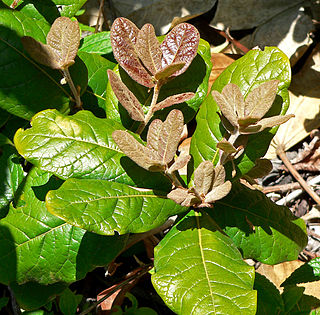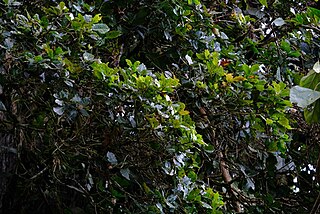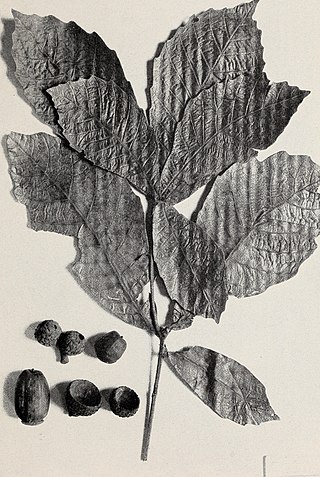
Central America is a subregion of North America. Its political boundaries are defined as bordering the United States and the Gulf of Mexico to the north, Colombia to the southeast, the Caribbean Sea and the Gulf of Mexico to the east, and the Pacific Ocean to the southwest. Central America is usually defined as consisting of eight countries: Belize, Costa Rica, El Salvador, Guatemala, Honduras, Nicaragua, Mexico, and Panama. Within Central America is the Mesoamerican biodiversity hotspot, which extends from southern Mexico to southeastern Panama. Due to the presence of several active geologic faults and the Central America Volcanic Arc, there is a high amount of seismic activity in the region, such as volcanic eruptions and earthquakes, which has resulted in death, injury, and property damage.

A cloud forest, also called a water forest, primas forest, or tropical montane cloud forest, is a generally tropical or subtropical, evergreen, montane, moist forest characterized by a persistent, frequent or seasonal low-level cloud cover, usually at the canopy level, formally described in the International Cloud Atlas (2017) as silvagenitus. Cloud forests often exhibit an abundance of mosses covering the ground and vegetation, in which case they are also referred to as mossy forests. Mossy forests usually develop on the saddles of mountains, where moisture introduced by settling clouds is more effectively retained.

Werauhia insignis is an epiphyte in the montane cloud forests of Central America distributed through native Costa Rica and Panama.

The Cordillera de Talamanca is a mountain range that lies in the southeast half of Costa Rica and the far west of Panama. Much of the range and the area around it is included in La Amistad International Park, which also is shared between the two countries.

Quercus costaricensis is a species of oak native to Central America. It is often found with Quercus copeyensis in the upper montane forests, to 3,100 metres elevation. The leaves are tough and leathery with a short petiole and toothed margin. Wind is the primary pollinator. Squirrels are their main seed predator but also their main disperser as they commonly lose their buried seeds.

The Talamancan montane forests ecoregion, in the tropical moist broadleaf forest biome, are in montane Costa Rica and western Panama in Central America.

The Costa Rican páramo, also known as the Talamanca páramo, is a natural region of montane grassland and shrubland of Costa Rica and western Panama.

Quercus copeyensis is a species of oak endemic to the Talamancan montane forests of Costa Rica and Panama. It is commonly called Panamanian oak.

Cryosophila is a genus of medium-sized fan palms that range from central Mexico to northern Colombia. Species in the genus can be readily distinguished from related genera by their distinctive downward-pointing spines on the stem, which are actually modified roots. They are known as the "root spine palms".
Ilex pallida is a species of plant in the family Aquifoliaceae. It is found in El Salvador, Honduras, Nicaragua, Costa Rica, and Panama. It is threatened by habitat loss.
The Central America bioregion is a biogeographic region comprising southern Mexico and Central America.
Werauhia lyman-smithii is a plant species in the genus Werauhia. This species is endemic to Costa Rica.
Werauhia picta is a plant species in the genus Werauhia. This species is native to Costa Rica.
Werauhia ringens is a species of flowering plant in the family Bromeliaceae. This species is native to Costa Rica and Ecuador.
Tylopilus bulbosus is a bolete fungus of the genus Tylopilus. Described as new to science in 2001 by mycologists Roy Halling and Greg Mueller, it is found in Costa Rica, where it grows on the ground in montane forests dominated by the oak species Quercus copeyensis, Q. oocarpa, and Q. seemannii. The fungus produces fruit bodies with convex to flattened caps measuring 4.5–11 cm (1.8–4.3 in) in diameter. Its color is initially violet to purplish brown, and eventually fades to brown. The pore surface is initially pale pinkish purple to grayish red, and bruises brown where it has been handled. The white flesh stains pinkish brown where it has been exposed. Spores are more or less spindle shaped (subfusoid), smooth, and measure 10–14 by 4.2–5.6 μm; the fresh spore deposit is pinkish. Morphologically similar Tylopilus species include the eastern North American T. rubrobrunneus and the North and Central American T. williamsii.

Quercus oocarpa is a Mesoamerican species of oak.

The Northwestern Andean montane forests (NT0145) is an ecoregion on the Andes mountains in the west of Colombia and Ecuador. Both flora and fauna are highly diverse due to effect of ice ages when the warmer climate zones were separated and the cooler ones combined, and interglacial periods when the reverse occurred. Because the environment is hospitable to humans, the habitat has been drastically modified by farming and grazing since the Pre-Columbian era.

Winifred Hallwachs is an American tropical ecologist who helped to establish and expand northwestern Costa Rica's Área de Conservación Guanacaste (ACG). The work of Hallwachs and her husband Daniel Janzen at ACG is considered an exemplar of inclusive conservation.

Sciodaphyllum pittieri is a species of flowering plant in genus Sciodaphyllum. It is native to the mountain forests of Costa Rica and western Panama.













